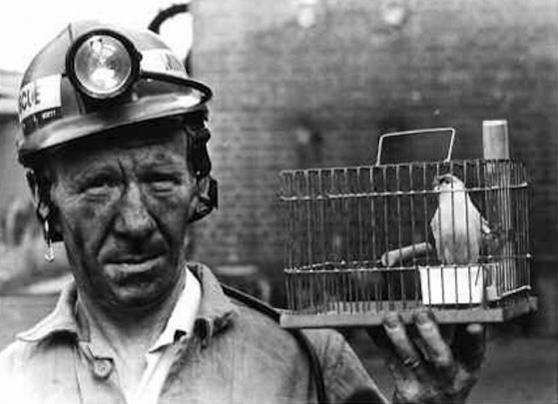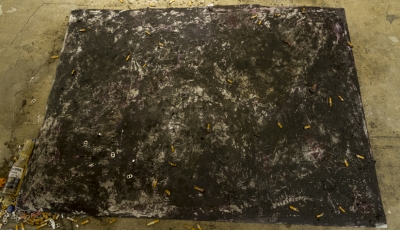Event Details

archival image, credits unknown
Susan Aydan Abbott, Sandra Campbell, Yvette Cenerini, Marie LeBlanc – Curated by Sigrid Dahle
March 4th, 2016 to April 16th, 2016
Opening: March 4th, 5-8pm
Panel Discussion: Disability + Curating, March 19, 3pm
with speakers Sigrid Dahle, Jenel Shaw and Jess Turner
Like the melodic birds with the presentient lungs, artists Susan Aydan Abbott, Sandra Campbell, Yvette Cenerini and Marie LeBlanc artfully bear witness to environmental failures of the life-threatening kind. Scratching, pushing, pulling, tracing, pressing, shuttering and brushing their images into existence, all four artists simultaneously celebrate the creative resilience and adaptability of all living things. Poignantly, the question remains: what’s in it for the canary?
This exhibition is in partnership with Arts & Disability Network Manitoba.
__________
Curatorial Statement by Sigrid Dahle
EVERYTHING IS NOT FINE: Creative Resistance in the Company of Friends
…I think that despair is the only appropriate intellectual stance in this time. But I also think that despair and joy are not irreconcilable, as despair is the mood of the intellectual mind, while joy is the mood of the embodied mind. Friendship is the force that transforms despair into joy…[1]
If this exhibition is any indication (and I think it is), the canaries and other deeply attuned beings living among are showing signs of distress. EVERYTHING IS NOT FINE.
In Yvette Cenerini’s print media rendition of silent spring,[2] the symphonic texture of wild birdsong diversity gradually gives way to a blank white-walled stare. In Sandra Campbell’s garden, a generous cornucopia of print media plant specimens are pinned, salon-style, to a toxic-hued gallery wall. By combining images that evoke the centuries-old practice of biological illustration with contemporary approaches to gallery installation, both artists remind us that individual subjects/objects are always an effect of the ground (or air) that holds them. We are all in this together; none of us can beat a hasty retreat from planet earth.
In Marie LeBlanc’s Zoo (a work in three iterations), life-sustaining environments designed to ensure provisional safety for endangered species (whether human or animal) contribute to social isolation as well as “the spectacle of the ‘other’.”[3] But what’s the alternative? Just ask the canary.
Susan Aydan Abbott’s four-component, no-holds-barred installation forcefully confronts us with yet another painful truth. Failure to protect the vulnerable (in particular, children) leaves a legacy of unimaginable suffering and grief that endures for a lifetime and well beyond. When does the collateral damage end?
The resonance between the works in the exhibition, and the bleak scenario they artfully propose, is not a result of my curatorial vision – I didn’t go looking for it. Rather, these poignant narratives of environmental breakdown and loss, found me. They insinuated themselves in my thoughts; they poked, prodded, whistled and warbled. They made demands; they insisted on seeing the light of day. In other words, the art did what art is supposed to do.
The exhibition, Canary in the Coal Mine, comes at the end of a year-long program in which Martha Street Studio (MSS), in partnership with Arts & Disability Network Manitoba (ADNM), mentored four artists self-identified as persons with disabilities. Covering everything from training in printmaking to professional development workshops, the program is “designed to help participants overcome physical, cognitive and social barriers that artists often face when interacting with the larger art community and the general public.”[4]
In my role as curator of the culminating exhibition, I was first introduced to Yvette’s, Sandra’s, Marie’s and Susan’s work last August, just four months into the program, when I participated in one of the group’s weekly meetings. Even then I was struck by the uncanny conceptual overlap between their respective bodies of work. Months later, as the project drew to a close, my initial observations were resoundingly confirmed. Hence, the title of the show.
But fortunately this curatorial thesis doesn’t end there. As I observed each artist’s intense engagement with process — how they fiercely, skillfully and playfully scratched, gouged, pushed, pulled, peeled, traced, pressed, shuttered, found, brushed, conceptualized and worried their work into existence – my thoughts turned to creative resistance and the inherent adaptability of all living beings. (Did you know, for example, that “[w]orldwide, more than 500 species of insects, mites, and spiders have developed some level of pesticide resistance”?[5]) And further, as I witnessed the artists’ collective support for each other’s practices and person, as well as the warmly productive context created by MSS’s staff, I recalled the words of Italian theorist and activist ‘Bifo’ Berardi, with which I began this text: “despair and joy are not irreconcilable.”
When we collectively generate holding environments that are actually worthy of the name – social and material contexts in which we feel supported and fully alive, at least for a time – we literally change the narrative. When we nurture friendships, viscerally and conceptually commit ourselves to bringing new ways of seeing and knowing into the public sphere, creatively adapt to our own and each other’s needs – or a potent combination of all three – we continue to hear the canary’s melodic song.
[1] Franco "Bifo" Berardi, “The Message of Francis,” SUPERCOMMUNITY, e-flux journal #65 (2015): n.p. Accessed February18, 2016.
[2] Published in 1962, Silent Spring is an environmental science book written by Rachel Carson that documents the detrimental effects of pesticides, particularly on birds. It is credited with igniting the contemporary environmental movement.
[3] “The Spectacle of the Other,” written by Stuart Hall, is the title of the fourth chapter in Representation: Cultural Representations and Signifying Practice (London: Sage Publication, 1997). While it shows how film, media and image are used to perpetrate racial stereotyping, Hall’s analysis is relevant to other contexts in which the construction of cultural difference is at play.
[4] Larry Glawson, “Making Our Mark – Notes on the Project,” Making Our Mark, Winnipeg: Martha Street Studio, 2014: n.d.
[5] “How pesticide resistance develops,” Michigan State University Extension. Accessed Feb 28, 2016.
__________
Originally from Port Arthur Ontario, Susan Aydan Abbott attended the University of Manitoba Fine Arts program from 2009-2011. She has since continued exploring varying subject matter and materials in her painting-based studio practice and has been featured in a multitude of exhibitions in Winnipeg, including a solo exhibition at the Edge Gallery in 2012. Susan shares her life story through her work as an artist and speaker for CMHA and United Way.
Sandra Campbell is a Winnipeg based, multi-media artist, working in painting, photography, video, printmaking and installation. She graduated from the University of Manitoba with a BFA (honours) in 2005. Campbell’s work has been featured in several group exhibitions in Winnipeg and used by the Mennonite Central Committee for reflection and meditation. Campbell has also shown work in Toronto at the Joseph D. Carrier, Columbus Gallery. Her work is held in private collections.
Yvette Cenerini is a Winnipeg based Franco-Manitoban visual artist. She studied psychology, zoology and education before obtaining her BFA from the University of Manitoba in 2010. The complexities and intimacies of interspecies relationships has been a recurring theme in all of her work. Cenerini has exhibited in Ottawa, Montréal and throughout the Province of Manitoba and has received grants from both the Winnipeg Arts Council and the Manitoba Arts Council.
Marie LeBlanc grew up in The Pas and lives in Winnipeg, MB. She is a self-taught photo-based artist inspired by the world around her, capturing natural layers, reflections, colours and shapes. Marie holds a Bachelor of Arts (Advanced) Degree from the University of Manitoba (1989) and is a graduate of Artbeat Studio’s artist in residency program (2012). She has exhibited extensively throughout Manitoba and her photos have been published in Geez magazine and Community New Commons.















